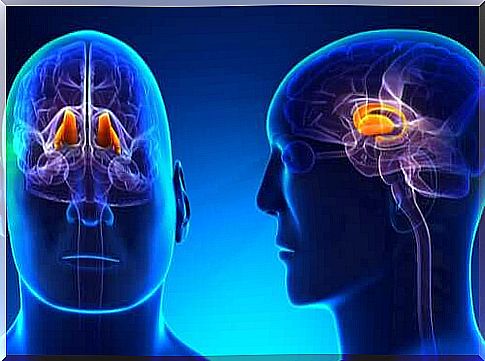How Do Humans Perceive Pain And Temperature?

Have you ever wondered how a human being perceives pain and temperature? What allows us to have this knowledge so relevant to our survival?
In this article, we will talk about the somatosensory system, which is responsible not only for making us perceive pain and temperature, but also for making use of the sense of touch. In addition, it takes care of proprioception: knowing the position in which our body is.
The somatosensory system is one of the largest systems in the human body. It is responsible for processing all sensory information (for example, pain and temperature), coming from the soma – body, bones, muscles, viscera – or from the skin, because all its receptors are distributed throughout the body.
There are, therefore, two somatosensory systems:
- Cutaneous somatosensory system: it is composed of skin receptors and, therefore, it is peripheral – it is found throughout the body. It has kinesthetic receptors that inform the body’s position and movements. They are also found in places like joints and tendons.
- Organic somatosensory system: has receptors in bones and viscera and is internal.

Cutaneous somatosensory system: the key to understanding perception
To understand how humans perceive pain and temperature, it is important to understand how skin receptors work. Among them are the most sensitive receptors capable of generating pain sensations.
The skin is the largest organ in the body and therefore the largest receptor. All over the skin, there are a large number of receptors grouped differently, which allows us to define the sensitivity or any of the four sensations we receive through it: pressure, vibration (touch), pain and temperature.
Therefore, through the receptors of the cutaneous somatosensory system, we receive information from the environment in the form of pressure, touch, pain, cold and heat.
Is it important for the skin to have hair?
We could distinguish between fur with and without fur. Skin with hair is the vast majority, but in the region without hair, there are many more receptors. Therefore, it is more sensitive because there are more skin receptors.
The most sensitive sensory organs would be the lips, the external genitals and the fingertips, as there is a greater density of receptors in these places.
Although this has not been fully proven, it is believed that fur with fur is more sensitive to vibration or touch as this causes the fur to move.
What are the receptors we have in the skin?
Skin receptors are divided into two categories: free nerve endings and encapsulated receptors.
Free nerve endings (TNL) are nerve extensions that reach the skin and are possibly the simplest sensory receptors. They are spread throughout the skin and are the most sensitive receptors for pain perception.
Although they are also useful for noticing everything else, they are specialized in pain. There is specificity but not exclusivity.
The TNL transduction mechanism is just the stretching of a specific part of them, which allows the opening of the sodium channels and, from there, the membrane depolarization, reaching the action potential. It produces cold by contraction and heat by expansion.
Encapsulated receivers: everything they do inside your capsule
Encapsulated receptors are a type of cutaneous receptor. They are named this way because they are covered by a capsule. There are those who speak of four types, others of five. These receivers are classified as follows:
Paccini corpuscles: pressure and touch sensitive
They are found on hairless skin and, to a lesser extent, on hairy skin. They are densely grouped on the lips, mammary glands and external genitals. They are especially sensitive to pressure, vibration and, to a lesser extent, pain and temperature.
Ruffini’s small corpuscles
They are small encapsulated receivers. They have nerve endings, like free nerve endings, just surrounded by connective tissue. They are found on hairy skin and respond to low frequency vibrations.
The soft touch of Meissner corpuscles
They are responsible for the soft touch sensitivity. They are found on hairless skin and inserted into the papillae of the dermis.
Krause’s sensitive end bulbs
Krause’s end bulbs are found only at the intersection of the mucous membrane with dry skin. Its fibers are unmyelinated and are extremely sensitive to pressure. Its pressure activation threshold is the lowest in the entire human body.
Merkel’s Slow Discs
Merkel’s discs occupy a similar place to Meissner’s corpuscles in the papillae of the dermis. They are slow adapting receptors and respond to a continuous change of stimuli, not directly – for example, the perception of adaptation to temperature.
The perception of pain
The perception of pain and temperature, in this specific case, constitutes an adaptive alert system that allows us to avoid sources that cause damage, although it is a sensation that can be influenced by emotional, psychological, social, medication, placebos, factors, hypnosis…
Therefore, it is a very subjective emotion, which suggests that there must be neural mechanisms that modify or interfere in the transmission of pain. This is not just based on skin receptors.
Pain is divided into two types:
- Avoidable pain: the body’s best response is to remove the source of pain, that is, the behavior.
- The inevitable pain: it exists at the peripheral level and at the central level and, as the name implies, we cannot escape it.
At the peripheral level – where we find the inevitable pain – it was noticed that in the organism there is molecular information linked to pain.
When there is pain, some cells are damaged and secrete histamine and prostaglandin. The second, by itself, has no effect, but histamine does, which causes the cells’ pain threshold to drop.
Prostaglandin makes damaged cells more sensitive to histamine, and the pain threshold lowers even further. There are pharmacological mechanisms to block histamine (antihistamines) and prostaglandin (acetylsalicylic acid).
Can we block the pain? The thalamus has the solution
At the central level, pain studies were directed to the thalamus. Pain is adaptive, but if it occurs with great intensity, it can block behavior. This is sometimes counterproductive, and some wonder how we could not feel pain. It is possible? How is the thalamus blocked?
Pain inhibition is often called analgesia, influenced by emotional and physiological factors. However, in people who have suffered strokes, it has been observed that injury or blockage of the ventral posterior nucleus of the thalamus usually occurs with the loss of cutaneous sensations, that is, superficial sensations of touch and pain.
Thus, damage to or blockage of the intralaminar nuclei eliminates deep pain but not skin sensitivity. Dorsomedial nuclei are related to the limbic system and generally interfere with the emotional components of pain, eliminating them.

The perception of temperature
The perception of temperature is relative, since we do not have receptors to perceive it in an absolute way. We can only notice sudden changes in temperature – for example, putting your hand in a container with very cold water and another with very hot water.
There are two types of receptors, one for cold and one for heat, distributed heterogeneously throughout the skin.
Cold receptors are closer to the epidermis, while heat receptors are deeper. They are the same receivers, they only differ in location.
Transduction in these receptors is produced by deformation of the membrane or cone of the receptor due to the effect of skin dilation or contraction. This causes the membrane and sodium channels to open.
If the receptors are densely grouped, the sensation of heat will be more intense. The associated nuclei for which we have difficulty in perceiving cold and heat are the intralaminar and, to a lesser extent, the ventricular.
Therefore, it is extremely interesting to note that pain perception is due, among other things, to small receptors in the skin and an excellent participation of the thalamus; so does the temperature.
All of these functions seem to have developed motivated by the search for our survival, and these tools that we possess are nothing more than a legacy of something our ancestors needed much more than we did.









